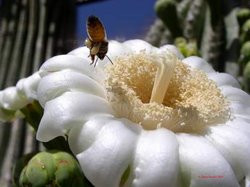Saguaro
|
|
| Saguaro Conservation status: Endangered | ||||||||||||||
|---|---|---|---|---|---|---|---|---|---|---|---|---|---|---|
 | ||||||||||||||
| Scientific classification | ||||||||||||||
| ||||||||||||||
| Binomial name | ||||||||||||||
| Carnegiea gigantea |
Saguaro (Carnegiea gigantea) is a large, tree-sized cactus that is native to the Sonoran Desert in the southwestern United States and northern Mexico.
Saguaros are slow growing, taking up to 75 years to reach the point where they will develop a side shoot. They live for about 200 years. They bloom in April or May. Many animals, such as the Cactus Wren, make burrows in saguaros. In addition to being slow growing, they are slow at propagating. These two factors combine to place the saguaro on the endangered species list. Harming one in any manner (including cactus plugging) is illegal, and when houses or highways are built, special precautions must be taken to move every saguaro affected.
The ribs of the saguaro are used for construction and other purposes by Native Americans of the region. A fine example can be seen in the roofing of the cloisters of the Mission San Xavier del Bac on the Tohono O'odham lands near Tucson, Arizona.
The saguaro blossom is the state flower of Arizona.
Sguaro1.jpg
Saguaro_forest.jpg

